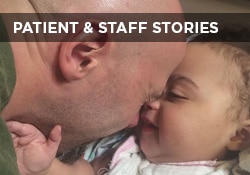This website uses cookies so that we can provide you with the best user experience possible. Cookie information is stored in your browser and performs functions such as recognising you when you return to our website and helping our team to understand which sections of the website you find most interesting and useful.

Susan E. Mazer, Ph.D. Blog
Thoughts and ideas on healthcare
Hi, and welcome to my blog! I'm Susan E. Mazer -- a knowledge expert and thought leader on how the environment of care impacts the patient experience. Topics I write about include safety, satisfaction, hospital noise, nursing, care at the bedside, and much more.
Patient Safety: The Tale of the Lost COW
April 28, 2017
 Hospital corridors, by design, are wide. They have to accommodate people, wheelchairs, gurneys, computers, meal carts, and all sorts of other things.
Hospital corridors, by design, are wide. They have to accommodate people, wheelchairs, gurneys, computers, meal carts, and all sorts of other things.
They just have to be wide.
The risk of being wide, however, is that there is enough room to add more equipment, such as computers on wheels (COWs). Inevitably, these COWs wander from floor to floor and multiply, creating risks for patient safety.
They are simply everywhere while they also seem to belong nowhere.
I often wonder if they are lost.
In many hospitals, there is neither a COW room nor a COW place. They, along with all sorts of other equipment just kind of hang out in the corridors.
According to the National Fire Safety Association (NFSA): “Projections into the corridor for wheeled equipment are permitted under three conditions: where the equipment does not reduce the corridor width to less than five feet (1.5 meters); where the fire plan provides for the relocation of the equipment in an emergency; and where the wheeled equipment is limited to equipment in use, emergency medical equipment such as crash carts or isolation carts, and patient lift and transport equipment.”
While permitted, what are the risks of storing carts in the hospital corridor to patient safety? Here is a partial list:
1. Falls
Patients who are medicated or who otherwise have balance issues may walk into carts and/or trip on them.
2. Blind-Sighted
Visitors and patients whose vision is compromised (such as loss of vision in one eye) may not see the equipment at all.
3. Confidentiality
Computers that are running and left on may reveal information that is covered by HIPAA.
4. Cleanliness/Infection Control
COWS sitting in hallways collecting germs and then are wheeled into patient rooms? A study that looked at the role of computers in spreading pathogens in hospitals, found that 93.3% of the studied keyboards were contaminated.
According to this research, the largest group of pathogens included Staphylococcus Spp which was found in 53.5% of the whole isolates, coliform bacteria which includes E.coli and Klebsiella comes next with 22.5%, while Bacillus Spp. and Pseudomonas Spp. were found in 21% and 2.8%, respectively.
High Price for Convenience
Basically, in this time of ad hoc cart storage, there is little good news other than convenience, for which a high price and high risk is being paid.
Cluttered hallways are falls waiting to happen. They carry safety risks for patients, visitors, and staff.
While regulations may allow equipment in the halls, regulations are made somewhere else and generalized across all hospitals. To keep patients mobile and safe, it makes sense to look around and take steps to remove obvious risks of falls.
 Idea: Not unlike a bike lane, why not paint a traffic line 2 ft. from the wall, thus defining the COW lane? It would provide a visible and familiar boundary for the “walk” lane and the “COW” lane, something that is very ambiguous at this time.
Idea: Not unlike a bike lane, why not paint a traffic line 2 ft. from the wall, thus defining the COW lane? It would provide a visible and familiar boundary for the “walk” lane and the “COW” lane, something that is very ambiguous at this time.
Patient safety sits everywhere: in the patient room, bathroom, and corridors. It’s time for hospital staff to rethink what they are doing as a habit and make it intentional — based on the best and safest way to store equipment.
P.S. If you like this post, please do me a favor and share on LinkedIn, Twitter, Facebook, etc. Also to get automatic notices when a new post is published, subscribe. No spam – just great content. Thanks!










